There was an exciting tactical battle between Mauricio Pochettino and Pep Guardiola back in 2016. As the new manager of Manchester City, Guardiola suffered his first loss in the Premier League at White Hart Lane in October that year. It might have been a little surprising as City had had a very strong start in that season – unbeaten and won their first 10 games out of 11.
However, Tottenham’s young and energetic squad gave Manchester City a very, very tough task. With the strong defensive displays, Tottenham quickly scored two in the first half, one through Aleksandar Kolarov’s own goal and the other one from Dele Alli.
In this tactical analysis, we will show you how Pochettino’s team beat Guardiola’s City in the Premier League. It is an analysis that focuses on the tactics of both teams.
Lineups
Tottenham played in a 4-4-1-1 formation. Their full-backs, Kyle Walker and Danny Rose were incredibly energetic and dominated the flanks. The team sheet placed Christian Eriksen as the partner of Victor Wanyama behind Alli while Moussa Sissoko played as the right-winger. In fact, the positionings were flexible at both ends, and we will explain the setups later.
After the 3-3 draw at Scotland, Guardiola started a slightly conservative team due to the absence of Kevin De Bruyne. Fernando played as the sole pivot, with David Silva and Fernandinho in front of him. It was a 4-3-3 formation in general.
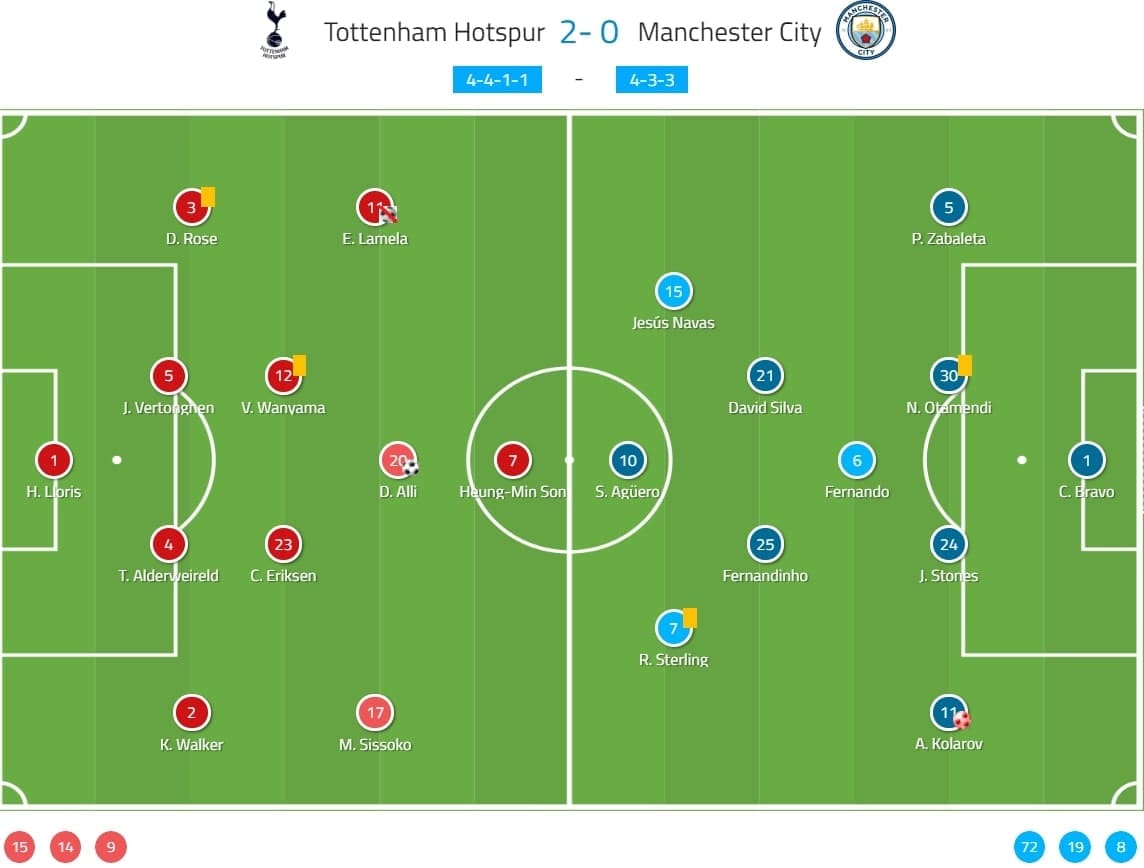
Pressing traps
The key for Tottenham’s early dominance was their press. Pochettino cleverly set a pressing trap to make City’s build-ups very difficult. There were a few considerations when arranging the duties, as Eriksen should be kept as the main man offensively, and the duties of him should be light. By positioning Sissoko near the midfield, Tottenham pressed in a narrow 4-3-1-2, with Alli joining Heung-min Son at the highest line.
The pressings were almost perfect in that game. It required a lot of training and stamina, and important pressing concepts such as covering shadows were involved. In general, the return pass to Claudio Bravo triggered the press from Alli, whose run had to cover John Stones in the meantime. The major duty of Eriksen was to man-mark Fernando, who was a less mobile player. Son was the other player to jump to another centre-back, who was usually Nicolás Otamendi. Wanyama often stayed at the centre, protecting the central third and securing the second balls.
And then there was arguably the most important part in the press, Erik Lamela. When Alli or Son was pushing high, the left-winger stayed narrow and shut the passing lane to the half-spaces. This prevented an initial pass to find either Fernandinho or Silva. Then, when the ball was guided wide to Otamendi or Pablo Zabaleta, it was the perfect timing for Lamela to press. He had to jump from his initial position and cover the half-spaces while pressing the wide players. This gave City tremendous pressure and they could hardly deal with it.
Therefore, despite possessing a numerical advantage in the wide areas as highlighted below, City were unable to utilise those spaces. The players were not thinking and deciding quickly for their next moves.
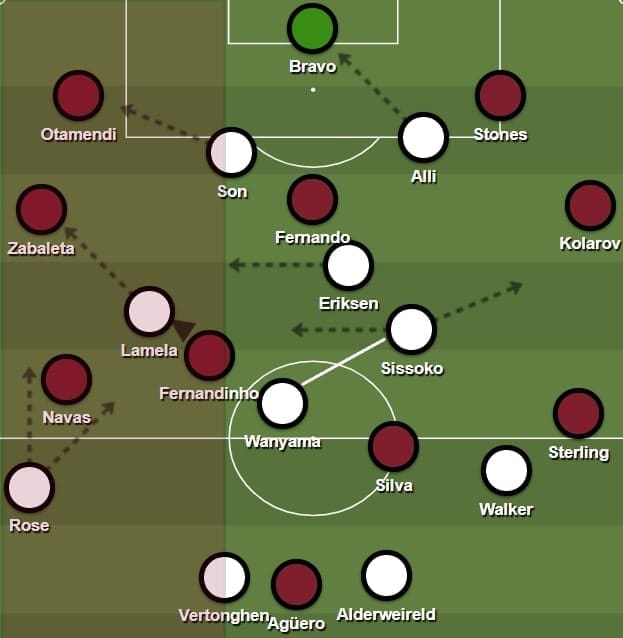
We can look at a game example: Stones’ pass to Bravo which triggered the press from Alli. You could see the Englishman was approaching Bravo while shutting the passing lane to Stones. Fernandinho was unavailable because of the presence of Son around him.
On this occasion, City did not fall into Tottenham’s pressing trap as explained. However, it was still a favourable condition as the home team also possessed the physical superiority to win the duels. For example, Rose easily won the ball from Jesús Navas to recover possession.
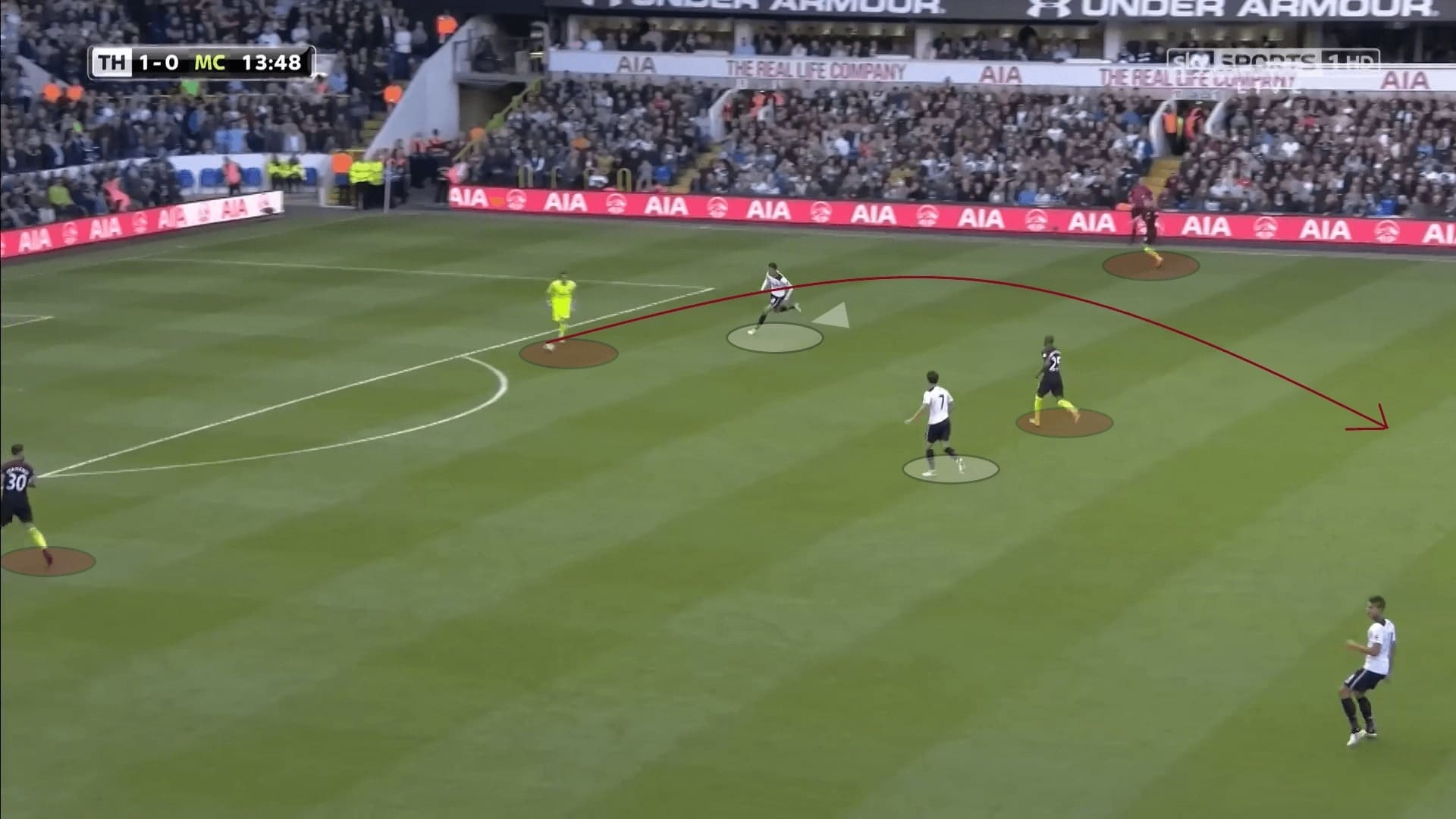
The incredible Wanyama and Sissoko
Wanyama and Sissoko were phenomenal in this game. Both were outstanding and this might have been one of their best games of the 2016/17 campaign. The coverage of these two players helped Tottenham to always regain possession. The intensity of their defensive efforts was very high, which City were not quite ready for early on.
As you can see in the recoveries graph below of both players (right: Sissoko; left: Wanyama), they almost covered all areas on the pitch. Sissoko had seven recoveries and Wanyama had 17, which were both higher than their season averages of 4.98 and 10.25, respectively.

Apart from the statistics, we can also use the below image to show the physical qualities of Sissoko. The ability of Sissoko to access a target when defending was incredible – despite the distance being large, he could still produce instant pressure on the receiver and made the whole press of the team very effective.
For example, Fernandinho came very deep to receive the ball in the below image. The Brazilian international was clever as he got rid of his marker by this deep positioning. In theory, he should have enjoyed time and space to execute his ideas. However, this advantage was totally nullified because of Sissoko’s press. As soon as Fernandinho received the ball, Sissoko just jumped to the Brazilian while covering his original target. The sprint was too quick, and he forced the ball long.
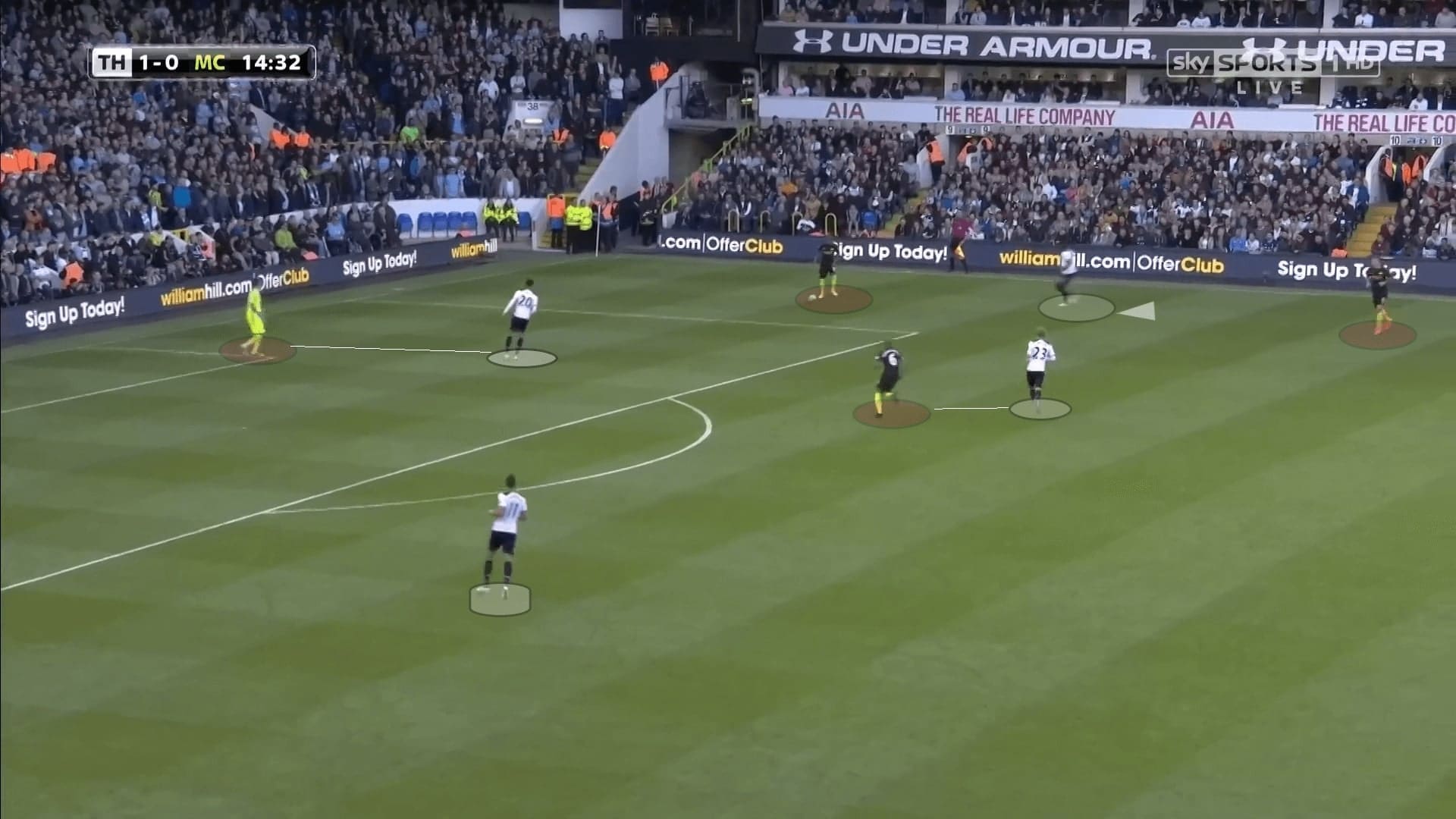
Both players also helped Tottenham keep a successful low block. In general, their back four remained very compact at the centre, the duties to cover the wide areas fell to Sissoko or Wanyama. The offensive threats of City’s full-backs were limited given the coverage of these hardworking players.
Collectively, these two were also vital as their relentless runs covered the loopholes. The below image is an occasion when Tottenham were partially man-marking the opposition. A pass would trigger the press and, when they pressed, the supports were good.
When Fernandinho passed to Raheem Sterling, Kolarov also made the run on the left channel, attempting spaces behind Walker. The Tottenham right-back had to jump out to approach Sterling. The run of Kolarov was totally covered by Sissoko and City could hardly develop the attack.
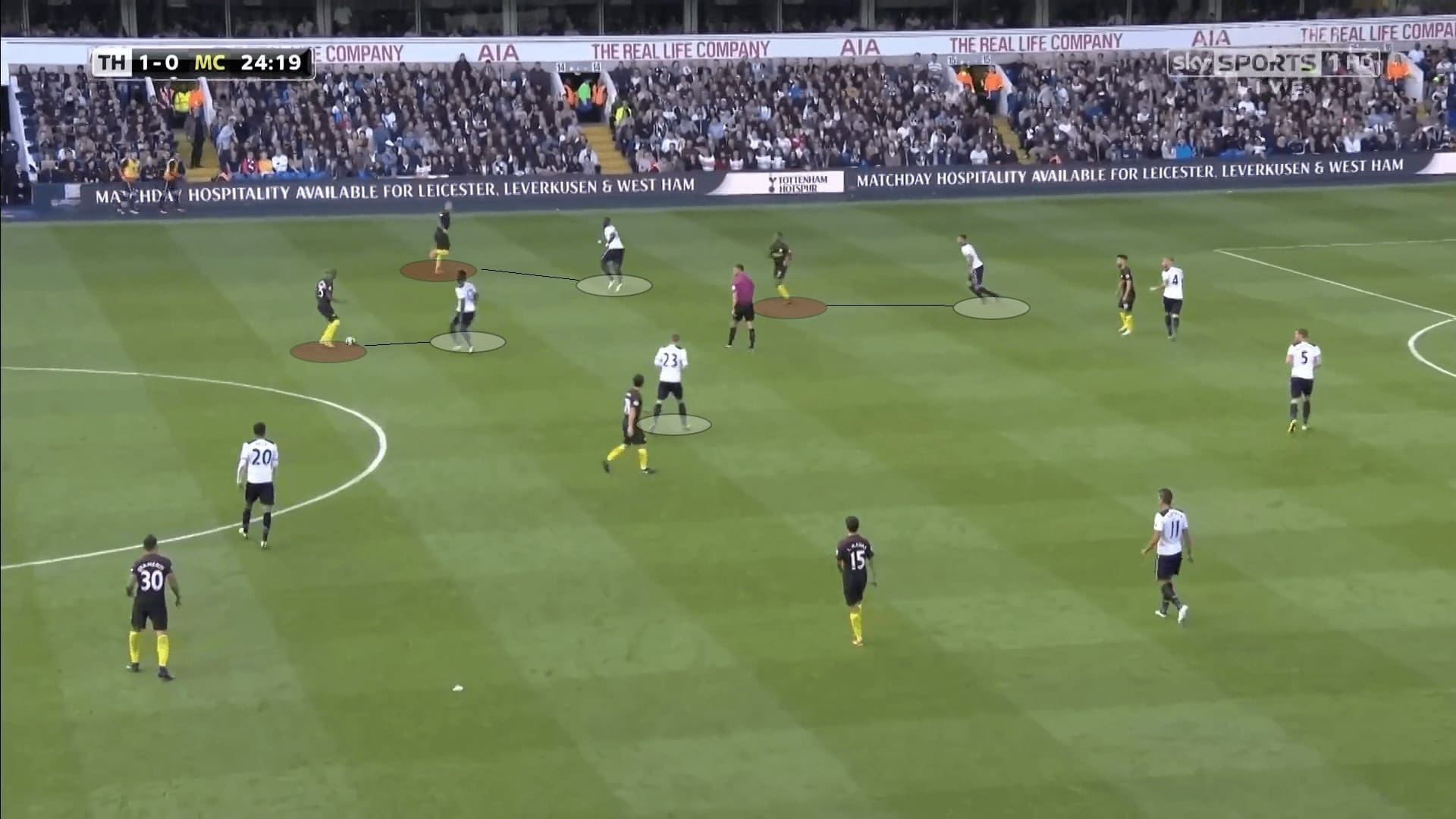
The build-up
The build-up of City was very ineffective in this game. In the first half, Fernando was the sole pivot and he could barely be involved in the build-up. As mentioned, he was man-marked by Eriksen on most occasions, which limited his time to adjust his body orientations when receiving the ball.
The below image is a passing map of Fernando in the game. The Brazilian completed 17 passes out of 19, which was 89.47% – a high success rate. However, if we looked at the positions and the directions of his passes, a large proportion were backward passes and none of them were passed to the final third. City clearly lacked a reliable source of producing the out-balls at the centre.
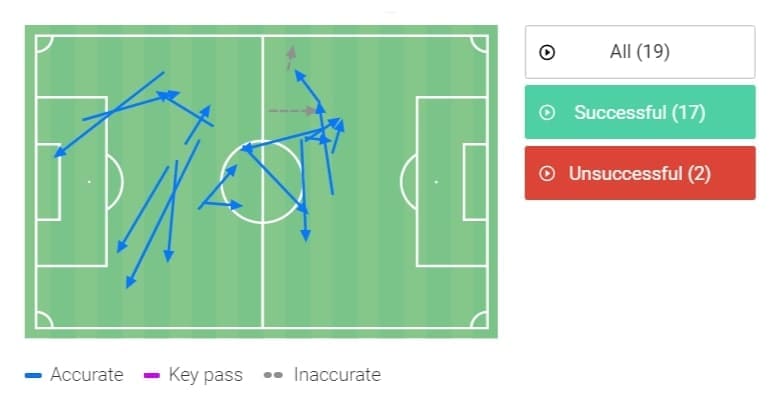
The situation was slightly better in the second half when Fernandinho was moved to Fernando’s role. The former Shakhtar man had a better mindset to progress the ball, also with better body orientations and broader vision. With Fernandinho, City were able to play out from the back, also it was because of the lighter pressing intensity from Tottenham.
Taking the below image as an example, Fernandinho received the pass from Bravo and created a 2 v 1 on Son with Otamendi. The most important fact was that he did not stop after passing to the Argentine, instead, he continued his run behind Son to receive the pass. Such interactions eased the pressure in the build-up.
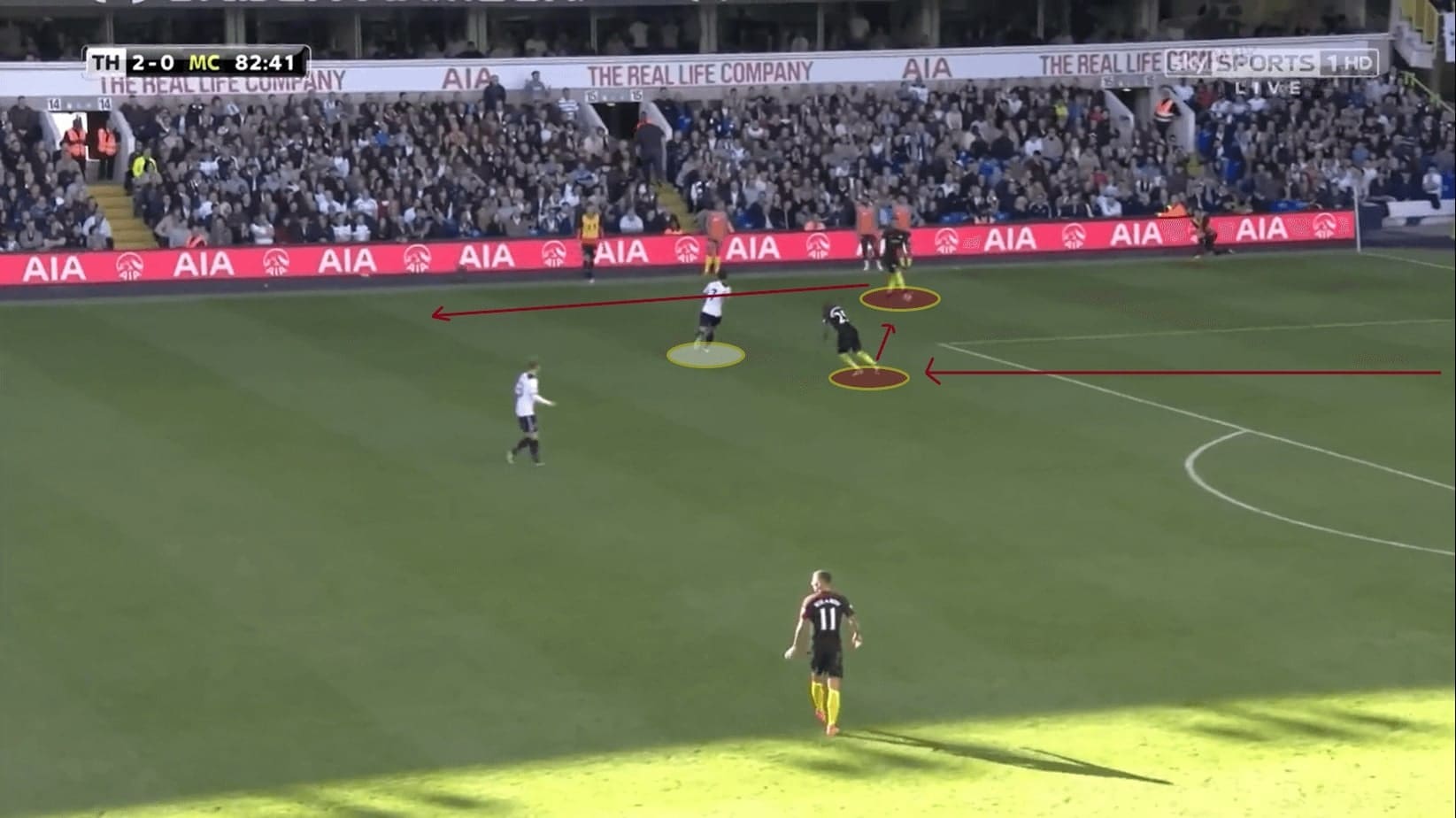
Numerically, City had Fernandinho and Silva at the midfield while Tottenham also had two when they pressed in a 4-4-2. The positionings of the Tottenham midfield pair could be manipulated easily as they were marking the closest targets tightly.
With Navas playing narrow it the midfield as an extra man, City had a 3 v 2 numerical advantage. You could see in the image below how both Tottenham players left the centre because of Fernandinho’s and Silva’s wide positionings, leaving Navas free to receive the ball. It was suboptimal as clearly a conventional winger like Navas was not comfortable in the centre, and the Spaniard sometimes missed the best timings to pass. Tottenham seized these delayed moments to cover the loopholes and reorganise.
However, as explained, despite all these advantages, they were nullified by the relentless defensive efforts of Tottenham. City just could not find the rhythm to break the press of Tottenham by the passes. On some occasions, Otamendi or Stones would carry the ball forward, but soon the attack lacked continuity because of the early pressure from Tottenham’s defence on the receivers.
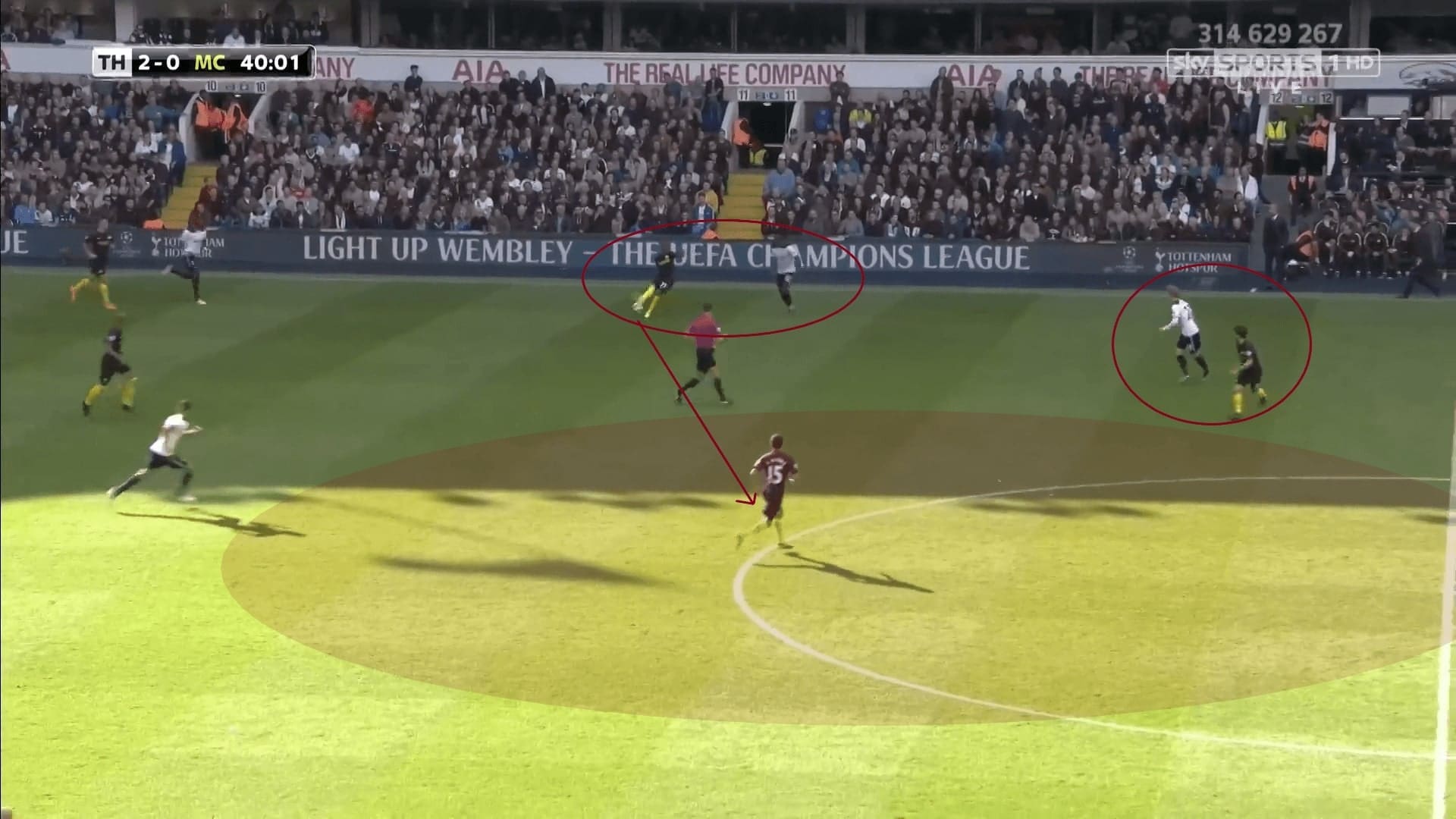
In the final third, the most threatening movements of City’s front players were the runs between the centre-backs. Most of the chances were generated by these runs. Sterling, Sergio Agüero, and Kelechi Iheanacho all tried, but they were unable to find the back of the net.
The key to making these runs possible was Silva. In the first half, he was bounded by his deep positioning and tight markings. When Ilkay Gündoğan came on, the Spaniard was freer as there was another player to work with him in the half-spaces and between the lines. However, the performance was unconvincing from the German, and the effects were limited.
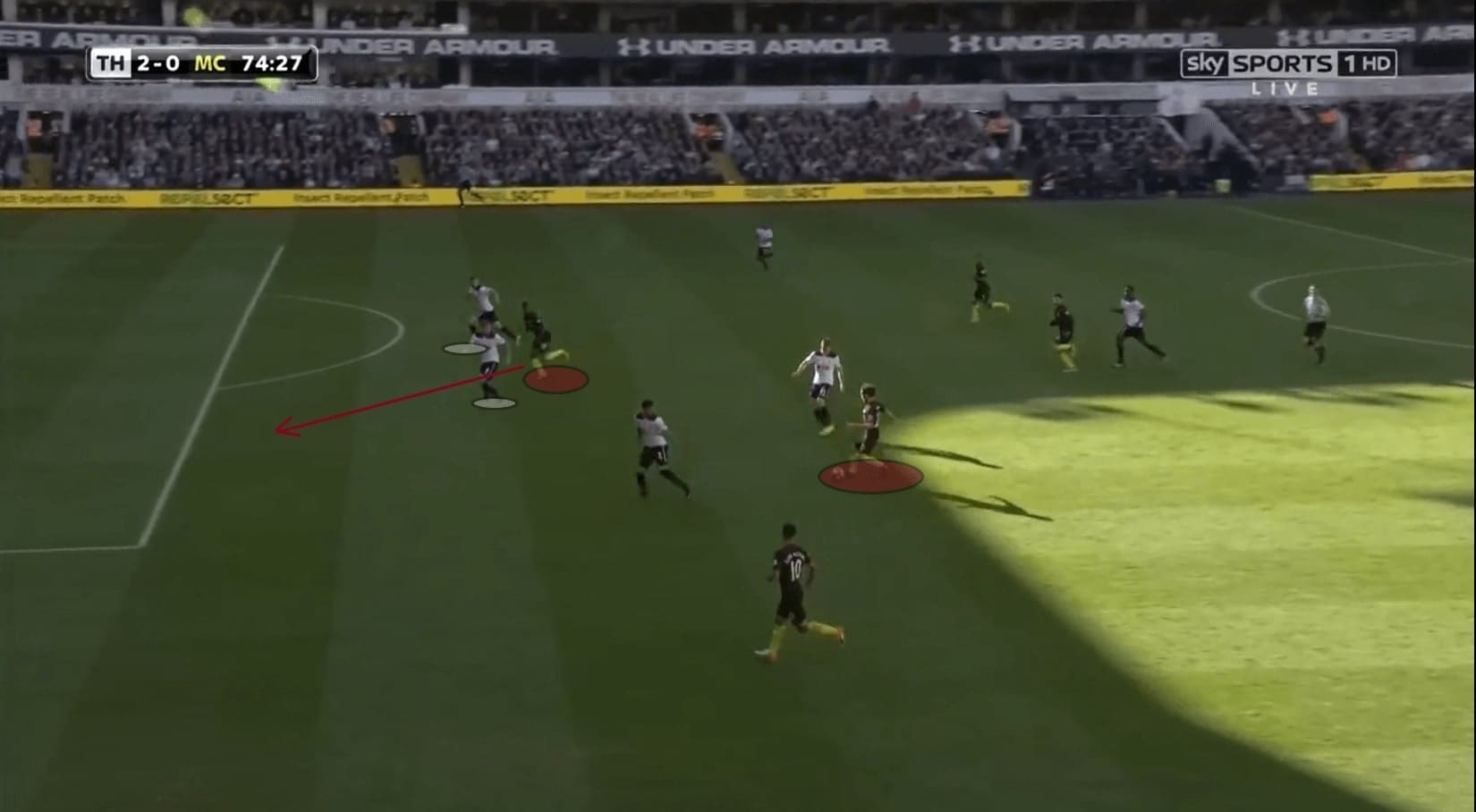
Tottenham offensive style of play
In this last section of our analysis, we are explaining how Tottenham attacked. Pochettino’s team were exploiting the flaws of City’s press, avoiding complicating and risky build-up in the backline. They were trying to hit City with quick plays and attack their exposed backline.
The below image is the passing links of the team. You could see that there are almost no interactions between the centre-backs and the midfielder. The passes mostly occurred between Eriksen and Son. It suggested how simple their attacks were. The top three passing links came from Walker and Sissoko (20), Eriksen and Son (18), as well as Lamela and Rose (17). These were very clear proof that penetrating centrally was unnecessary as they had very strong combinations at flanks.
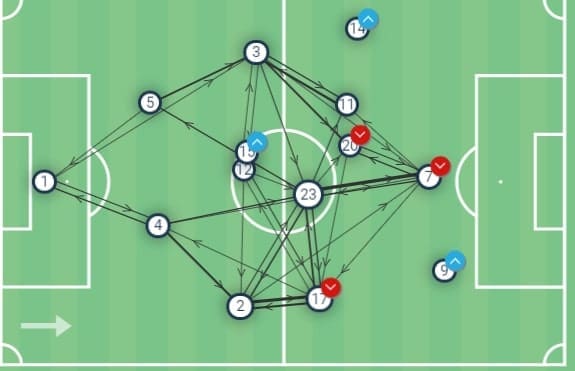
We tried to use the below image to sum up the offensive ideas of Tottenham. Despite it being a slightly direct approach, there were still objectives to reach some better conditions. In general, City pressed in a 4-4-2 but they were not assigning a player to join Agüero. Therefore, when the ball moved wide, a winger could step up and form the first line with the Argentine. This was how Tottenham exploited the press.
So when Sterling stepped up to approach Toby Alderweireld, Walker could be left free on the right. Meanwhile, Sissoko’s positioning always took Kolarov out of position and this stretched the City backline. With Son positioning himself between Stones, Kolarov, and Fernando, he became the free player between the lines to receive the ball in the attack. Meanwhile, Lamela and Alli also positioned themselves high to stretch the City defenders.
The abundancy of Tottenham players in the centre also allowed the Lilywhites to win a lot of second balls. They had both the physical and numerical advantage at the ball side.
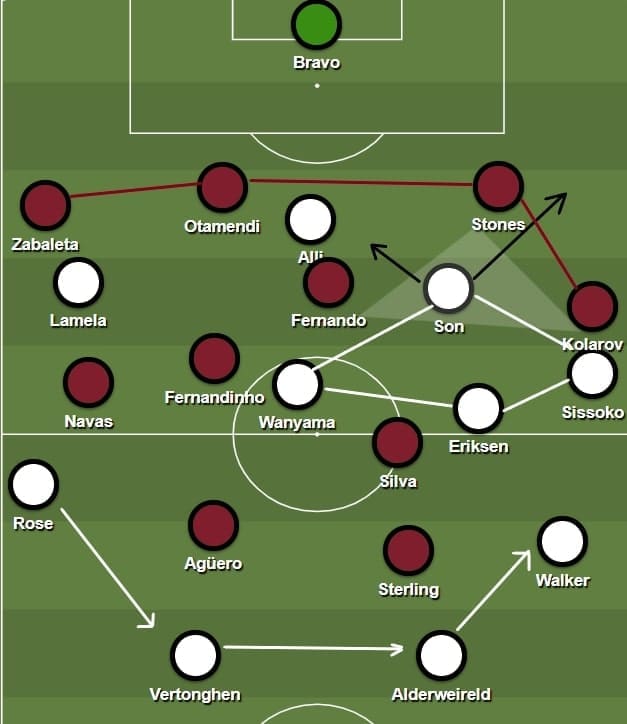
So, how to free Eriksen was a key component to the game. Pochettino did this by playing Sissoko with him, whose movements took away the oppositions and created space for the Danish international.
The below image is an example – when Sissoko received the ball on the right. Sterling was in the centre as he initially pressed Alderweireld, City were outnumbered as the ball easily passed through the first line of the press through Walker. In this case, Silva had to take care of both Wanyama and Eriksen, which was impossible. The Spaniard could only guess Sissoko’s pass, and he chose the wrong player.
Despite the suboptimal body orientation of Sissoko, he still managed to find Kolarov with the outside of his boot. Now it was awkward for Fernando as he had to make a hard call: choosing Eriksen or Sissoko.
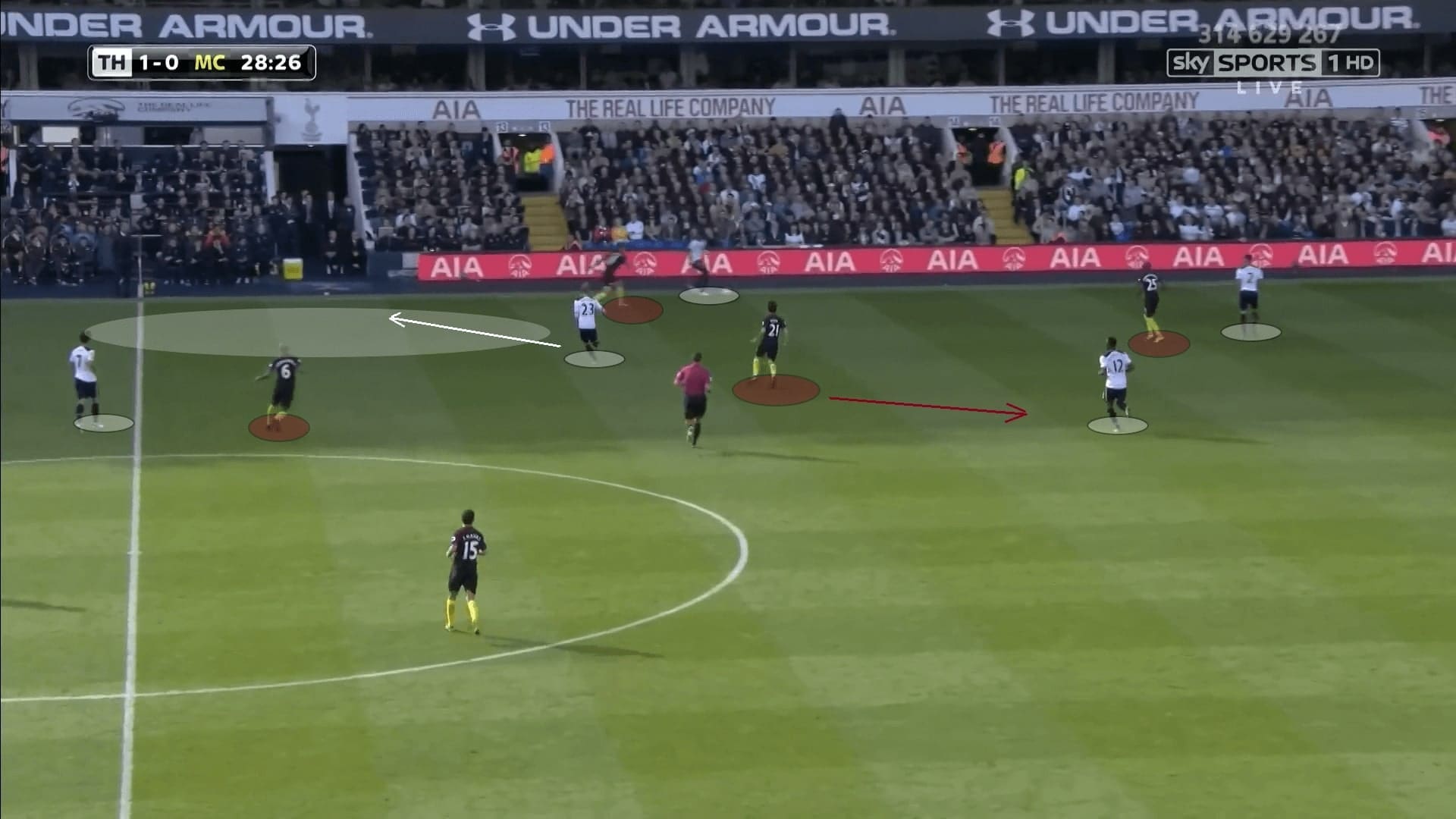
The below image is the heat map of Eriksen in this game. As you could see, despite being listed as the defensive midfielder on the team sheet, this is not a fixed position. He was very active in the right half-spaces, mainly because of the presence of Sissoko on the right as well. The Frenchman was happy to take left-back, Kolarov, with him widely while leaving more space for Eriksen to work with.
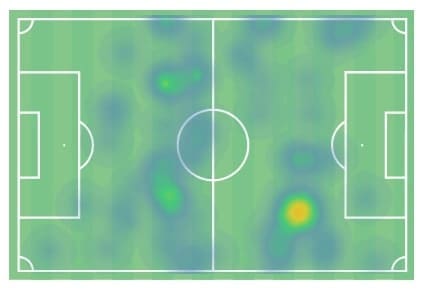
Another key component of Tottenham’s attacks was their third man runs. City suffered hugely because of these as it was unlikely to see Silva or Sterling track the players. Both players were kept high to get ready for the offensive transitions, but the impact was limited because of the intensive press of Tottenham.
Taking the below image as an example, Sissoko again dragged Kolarov very wide and opened the half-spaces for Eriksen. The Danish international, who initially stayed behind Sterling, timed his run correctly to receive the ball from Sissoko.
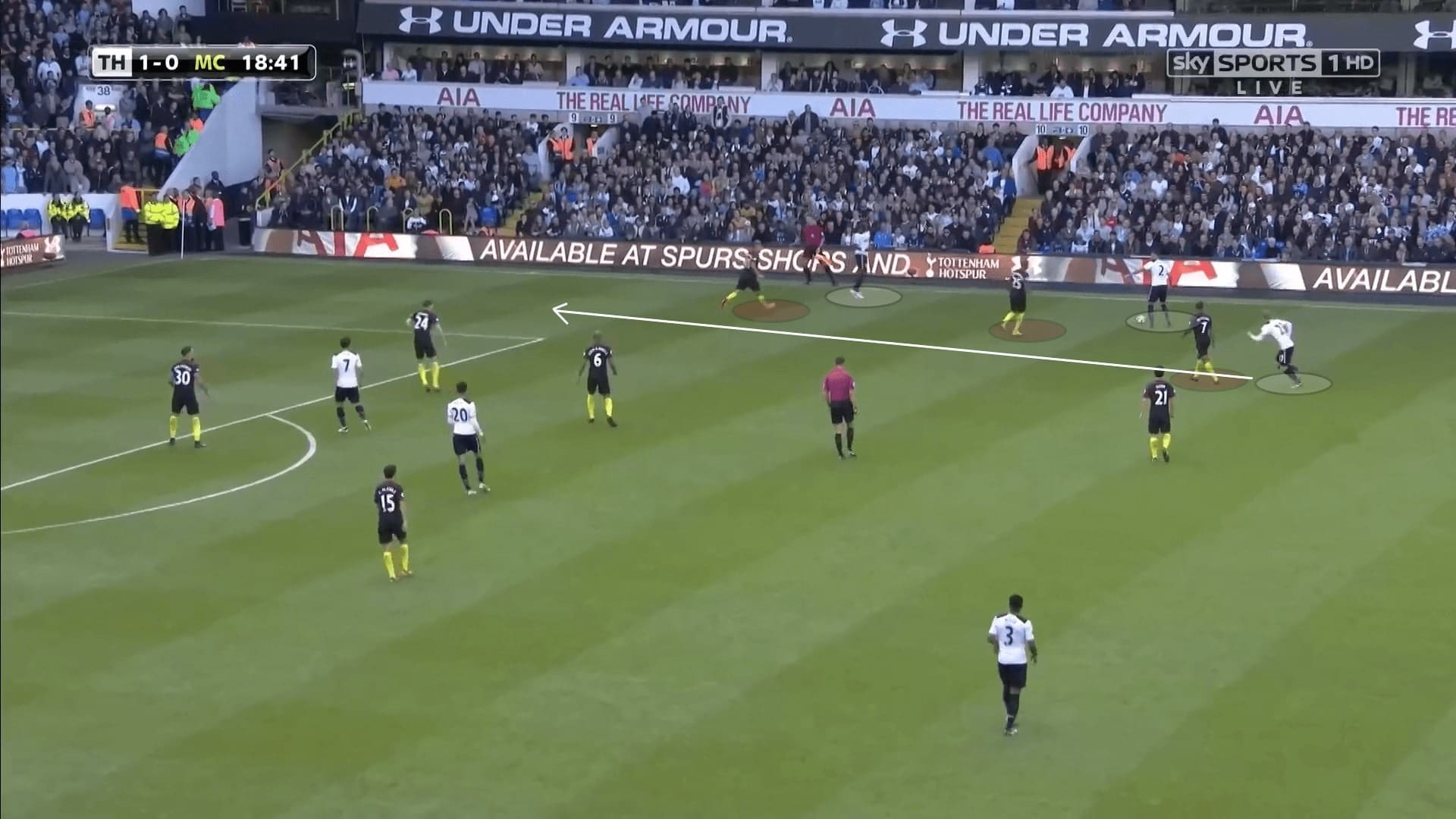
Tottenham also gained the advantage because of the physical superiority of players. Defensively, they won the duels easier and offensively, they were quick and never afraid of the contact. Since Guardiola played Fernandinho as the only defensive midfielder in front of the defenders, he had to make sure his challenges were right.
However, as explained, given the physical qualities of Tottenham players, Fernandinho’s job was very difficult. In the image below, the Brazilian challenged Walker but the right-back escaped, continued his run while none of the Citizens had the energy and pace to track his run. This resulted in the penalty.
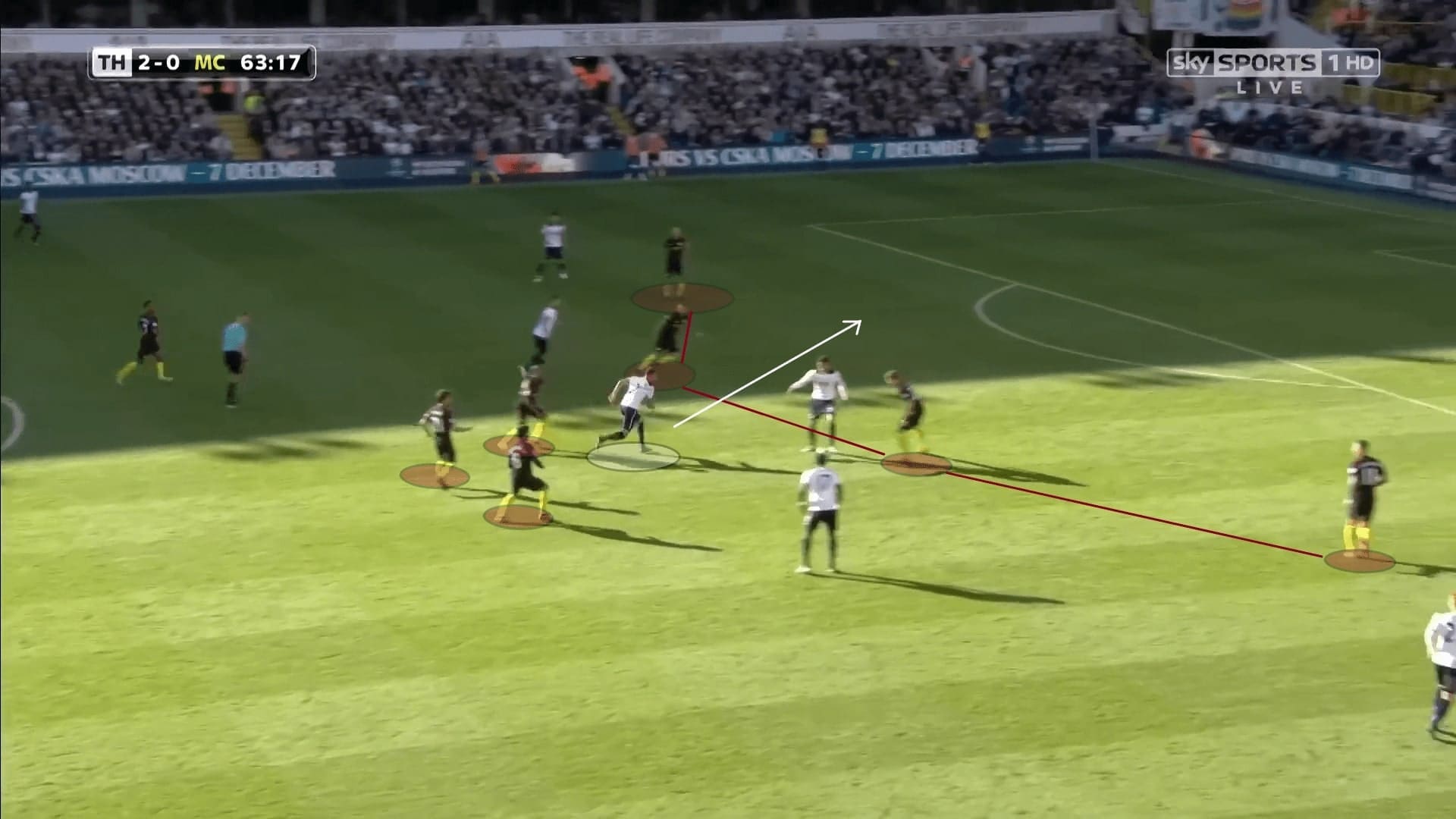
When attacking with some quick moves, Tottenham exploited the space behind the full-backs, forcing a City centre-back to step out. This was very effective to generate gaps between Stones and Otamendi, and both Lamela and Son were always ready to create those dynamics. In the meantime, as the supporting player, Alli would make the forward runs to exploit those gaps. The Englishman was young, quick, and intelligent, Fernando was unable to track him tightly and this tactic brought Tottenham the second goal.
The idea was highlighted in the above image. As Rose was charging forward, Zabaleta had to approach the left-back, while Lamela was running behind. This forced Otamendi to step closer to gain control on Lamela while Kolarov was occupied by Son. This was the moment for Alli to make those runs, while Fernando was unable to track him.
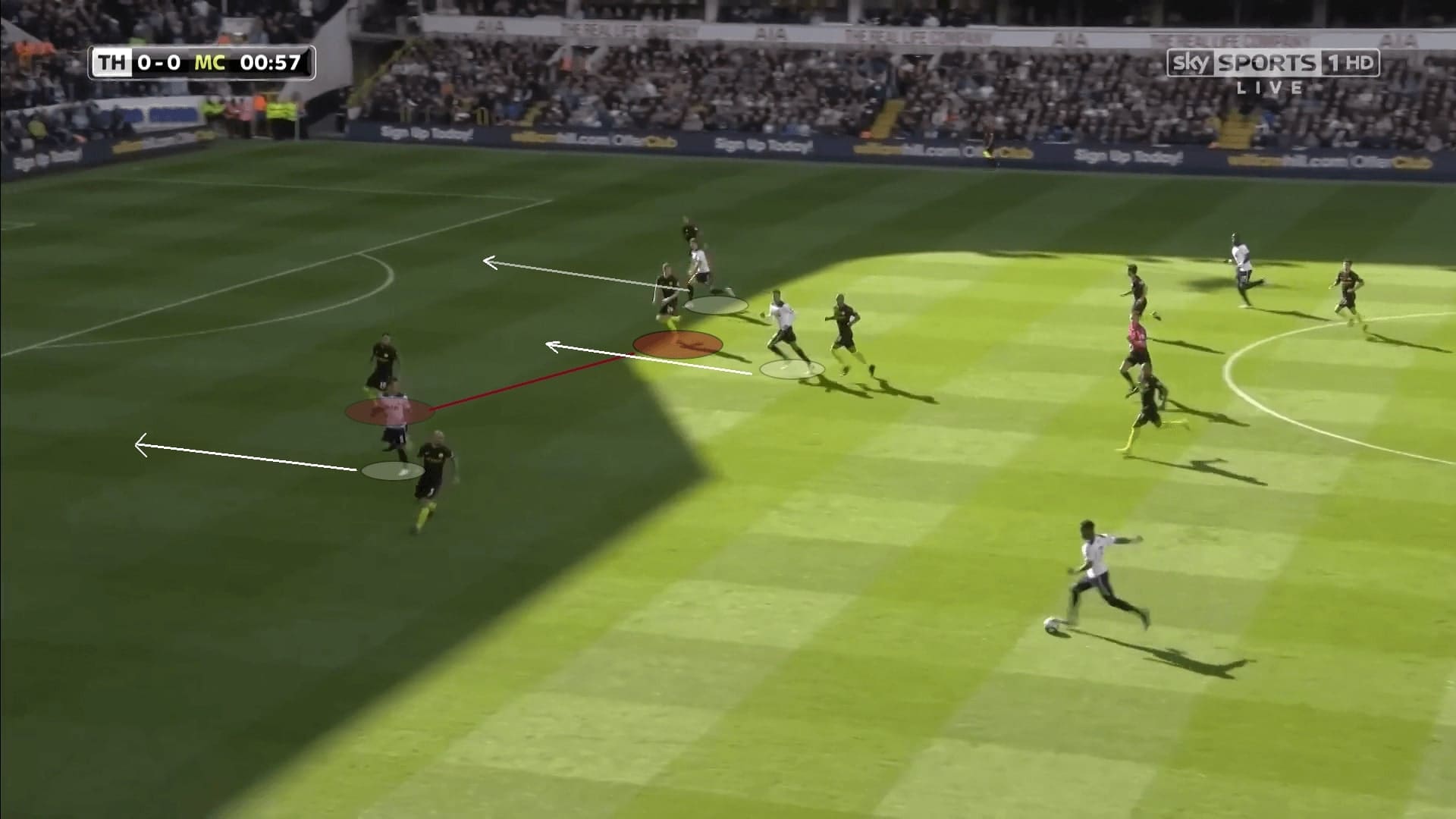
Conclusion
If we are looking at the xGs of both teams, City’s 1.67 was even higher than Tottenham’s 1.47, yet their numbers of shots were the same with 13 each. However, Tottenham had the early moments, took the lead from Kolarov’s own goal, which gave them a lot of confidence. Guardiola’s men were too nervous to find the rhythm.
This match exposed the issues of City’s build-ups, but it took Guardiola and his team a lot of time to counter the high press. In fact, similar issues happened in the 2016/17 campaign, for example, their vulnerability when facing heavy-pressing intensity was a weakness that resulted in their loss against Monaco.





Comments